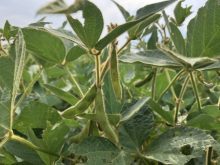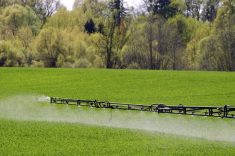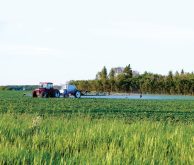Chicago | Reuters — Monsanto is launching the first product that deactivates a controversial herbicide inside spraying equipment after it is used, the company said on Tuesday, its latest attempt to prevent unintended crop damage associated with dicamba.
The new product aims to stop farmers from accidentally applying traces of dicamba on crops that cannot tolerate it when the chemical’s residue remains in spraying equipment.
Growers across the U.S. farm belt said last summer that dicamba herbicides, which are also sold by BASF and DowDuPont, vaporized and drifted away from where they were sprayed on soybeans and cotton that Monsanto engineered to resist the chemical. This damaged millions of acres of other crops, triggering lawsuits against the manufacturers and some state-level limits on the herbicide’s use.
Read Also

Huge crops in South America says analyst
Although there’s a debate over the size of the South American soybean crop, there’s little doubt that it will be an enormous one, said consultant Michael Cordonnier of Soybean and Corn Advisor in Hinsdale, Ill.
Further north, provincial officials in Ontario, Canada’s biggest soybean-growing province by area, reported relatively few such cases of dicamba drift last summer.
Monsanto has blamed much of last year’s field damage on improper applications, including by farmers who did not adequately clean spraying equipment. The company has said its dicamba-based herbicide is safe when used properly.
The product that deactivates dicamba will be launched in the coming weeks, as U.S. farmers advance crop plantings, said Ryan Rubischko, Monsanto’s dicamba portfolio lead.
“Having technologies like this, it helps farmers be able to really just focus in further on ensuring their sprayer systems are clean and preventing this from happening,” he said about equipment contamination.
Monsanto and Adjuvants Unlimited — billed as a privately-owned, Memphis-based maker of pesticide adjuvants and surfactants — tested the as-yet-unnamed product over the past few years, according to a statement.
The new sprayer cleaner technology is “unique” compared other currently commercially-available sprayer cleansers, Monsanto said, in that it’s based on “a chemical process that deactivates certain pesticide active ingredients, including dicamba.”
The new product is designed to be used within the rinse and cleanout processes specified on current dicamba product labels and best management practices, Monsanto said.
Weed experts doubted it would do much on its own to prevent the type of crop damage associated with dicamba in 2017.
“That’s not going to solve the problem,” said Bob Hartzler, an agronomy professor at Iowa State University.
Last year’s problems were more commonly associated with dicamba evaporating in a process known as volatilization and drifting, experts said.
In Indiana, contaminated tanks were linked to three per cent of complaints about crop damage associated with dicamba, according to a Purdue University presentation.
“That did not make but just a small fraction of the claims,” said Fred Whitford, director of Purdue’s pesticides program.
Monsanto, which is being acquired by Bayer, is banking on its dicamba-based herbicide, and soybean seeds engineered to resist it, to dominate soybean production in the U.S., the world’s second-largest exporter.
Facing complaints last year, the company proposed changes to the herbicide’s label instructions that the U.S. Environmental Protection Agency approved for 2018.
— Tom Polansek reports on agriculture and agribusiness for Reuters from Chicago. Includes files from AGCanada.com Network staff.
















